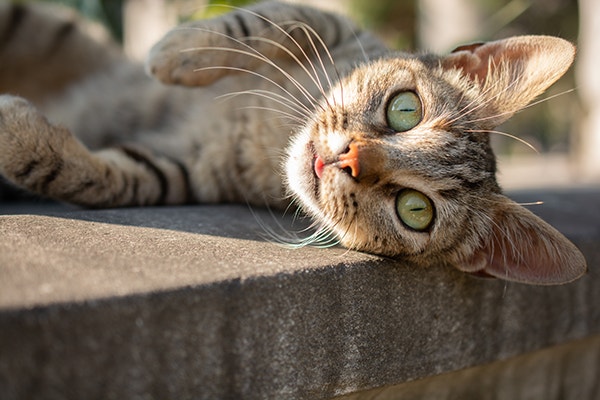Can Cats Eat Tuna? What You Need to Know


Share
Cats seem to love tuna - perhaps even more than they love their owners. The pungent smell and the fishy flavours are enough for a cat to want to devour an entire can of tuna. But should you let them? Truth is, cats require a carefully formulated balance of nutrients to support their growth, development and overall health. While tuna is an excellent source of protein, it lacks essential vitamins and minerals that cats need to thrive. That’s why it’s important for cat parents to really understand if their cat can eat tuna.
In this article, we help cat parents make an informed decision on whether tuna is good or bad for their cat. We discuss what forms of tuna are safe for cats to eat, the potential benefits and associated risks of tuna, and how much tuna is too much and why. By understanding how to safely incorporate tuna into your cat’s diet, you can ensure you’re caring for your cat and their well-being, whilst potentially offering a sneaky occasional treat.
Can cats eat tuna?
Technically yes, cats can eat tuna. Cats are obligate carnivores, which means they need plenty of protein – and tuna is an excellent source of it. However, there are various factors that cat parents need to consider before feeding a cat tuna - including what type of tuna cats can eat, which is what we discuss below.
Can cats eat raw tuna?
Raw tuna has a higher risk of bacterial contamination and may be host to parasite eggs, such as tapeworm larvae, which is why it is not recommended to feed cats raw tuna. A raw fish diet can also lead to Vitamin B1 deficiency, which can cause neurological problems.
Can cats eat cooked tuna?
Cooked tuna is a safer alternative for your cat, as the process of cooking will kill any bacteria or parasitic larvae present. If you want to feed a cat tuna, do not add any salt, seasonings or oil.
Can cats eat canned tuna?
Cats can eat canned tuna, as long as it is packed in spring water only and has no seasonings or additives. Never feed your cat tuna in brine or sunflower oil, which is for human consumption only. Brine is salt water, and its high sodium content can lead to an electrolyte imbalance in your cat. If your cat eats enough tuna in brine for it to be toxic, this can cause dehydration which may lead to kidney problems. Cats can’t eat tuna in sunflower oil as it’s difficult for them to digest and may cause gastrointestinal upset, such as vomiting and diarrhoea. We look at the risks of cats eating tuna from a can further below.
What are the health risks of feeding canned tuna to cats?
While cats can eat tuna occasionally, there are potential health risks. Tuna is high in mercury, a toxic metal that can accumulate inside the fish itself. Mercury is dangerous for cats to consume in large amounts as it can harm their kidneys and increase the risk of kidney failure. There is also risk of mercury poisoning which can cause neurological problems such as loss of coordination, tremors, dizziness, muscle weakness and seizures. Other symptoms of mercury poisoning in cats include gastrointestinal upset with vomiting and diarrhoea, or changes in their behaviour such as loss of appetite, agitation and depression. Look out for any of these signs and seek immediate veterinary attention if you suspect your cat has mercury poisoning.
Some cats may also have an allergy or intolerance, making tuna bad for those cats. Look out for symptoms such as itchy, red, swollen or bumpy skin, flaky or bald patches from hair loss or gastrointestinal problems such as vomiting, diarrhoea or loss of appetite. If you notice any of these symptoms after feeding your cat tuna, contact your veterinarian.
Besides canned tuna, cat parents may consider offering their cat plain, cooked and boneless chicken or fish as an occasional treat. However, it’s important to remember that any homemade or human food, including tuna, chicken, meat and other fish, will not provide all of the nutrients your cat needs. Solely feeding human foods to a cat can cause them to become deficient in, or consume excess of, certain vitamins and minerals, which can lead to other health issues. For example, Vitamin B1 deficiency can lead to neurological problems.
Instead, it’s recommended to serve your cat complete and balanced cat food like SHEBA® Wet Cat Food, which contains high-quality ingredients, proteins and vegetables, as well as important vitamins and minerals. You should provide your cat with a complete and balanced diet appropriate for their life stage - whether they’re a kitten, junior, adult or senior - and SHEBA® Wet Cat Food is specially formulated with essential nutrients to help your cat grow, develop and thrive. With a variety of flavours available, you can choose which protein you want to support your cat’s health, such as chicken, meat, salmon or another type of fish, and be rest assured they’re still receiving the nutrition they need.
We discuss how to minimise the risks of your cat eating canned tuna here.
What are the health benefits of canned tuna for cats?
Tuna is a healthy source of protein, B vitamins and minerals selenium and potassium. With tuna being rich in omega-3 essential fatty acids, it can promote good skin and coat health in cats, and has anti-inflammatory properties which can make canned tuna good for cats. Tuna is also low in carbohydrates, which reduces the risk of obesity and related health issues, such as diabetes and heart disease. Many cats enjoy tuna, and, in moderation, a very small amount can be added to your cat’s complete and balanced meal.
The nutritional value of canned tuna provides evidence of some of its health benefits. Per 100g of canned tuna, there are zero carbohydrates or sugars, only 1g of fat and a high amount of protein - around 25g. Tuna contains Vitamin B3 (11.5mg), Vitamin D (2.5mg) and Vitamin B12 (2mg). It also contains minerals such as sodium (230mg), phosphorus (190 mg), potassium (155mg) and selenium (45mg).
While cats can benefit from all of these vitamins and minerals, canned tuna is designed for human consumption. If you want your cat to eat tuna, consider SHEBA® Cat Food with Tuna, which provides a high amount of protein, as well as the right balance of vitamins and minerals that your cat needs - in the right amounts and ratios.
How to safely feed tuna to your cat or kitten
Cats can eat tuna from a can as an occasional treat, but it’s important that cat parents follow recommended guidelines for their cat or kitten. Remember that kittens under 8 weeks old nurse from their mothers and should not have any solid foods. When they transition to solid foods, it’s essential to provide kitten food which is specifically formulated to support their rapid growth and development in the first year of their life. A diet consisting solely of human foods can cause health problems through nutritional deficiencies or excesses in kittens.
If you want to treat your cat to some canned tuna, stick with the kind packed in water and skip anything that comes with oil, salt, or added flavorings. Drain it well and give it a quick rinse to cut down the sodium. If you’re using fresh tuna instead, cook it all the way through without adding spices, oil, or butter. Let it cool, then break it up into small, boneless flakes before serving.
Cat parents should understand the nutritional benefits as well as risks of tuna to decide whether tuna is good or bad for cats. You should also consider which types of tuna are safe and how much and often to offer your cat tuna. It’s always best to consult a veterinarian before making any new additions to your cat’s diet.
Below, we provide some practical tips on how cat parents can safely incorporate canned tuna into their cat’s diet occasionally.
- Use canned tuna in water. Cats can eat tuna in spring water on occasion. Cats should never eat tuna in oil or brine.
- No salt, seasonings or additives. Cats can only eat canned tuna that is free from salt, seasonings and additives.
- Avoid high levels of mercury. Certain tuna varieties have higher levels of mercury which can be toxic, so select your tuna carefully.
- Treat tuna as a treat. To limit mercury exposure, as well as vitamin and mineral deficiencies, you should only feed a cat tuna in very small amounts and as an occasional treat.
- Look out for allergies. Canned tuna is not good for all cats’ stomachs, so keep an eye out for any food allergy or intolerance symptoms.
- Control the portions. Tuna should be a small part of your cat’s overall diet, to ensure they receive the majority of their nutrition from complete and balanced cat food.
- Check with your veterinarian. It’s always recommended that you consult your veterinarian before offering your cat any new foods or placing them on any special diets.
How much tuna to feed your cat?
In regards to how much tuna cats can eat, it’s best to consider it as a treat. Treats should not make up no more than 10% of your cat’s daily caloric requirement, whereas one drained can of tuna contains more than 100 calories. As a rough guideline, if you want your cat to eat tuna, only give a very small amount once a week.
Too much tuna can also result in mercury toxicity in cats, may upset their gastrointestinal health, and can lead to picky eating habits. If your cat is eating too much tuna, they may have a reduced appetite for their main diet, which means they will begin to lack the essential nutrients they need for their overall health, causing vitamin and mineral deficiencies. Instead of tuna, check out how much wet food to feed a cat depending on their size and weight.
While it’s tempting to feed our cats food we know they’ll enjoy, such as tuna, it’s essential that cat parents proceed with caution with any human foods. Cats thrive best on a complete and balanced diet of cat food, specifically designed for their age, size, and health. For kittens, it’s even more important that cat parents look after their health, as their bodily systems are more delicate than that of an adult cat - hence why we have formulated SHEBA® UK Wet Kitten Food. Learn more about the difference between kitten food and cat food, and find out when and how to make the transition.
CAN CATS EAT TUNA: FAQ
Can cats eat raw tuna?
No, cats should not eat raw tuna. Raw fish has a high potential for bacterial and tapeworm larvae contamination, which is why it’s best to thoroughly cook fish to kill the bacteria. If your cat eats raw tuna regularly, this can also cause a Vitamin B1 (Thiamine) deficiency which can lead to neurological problems.
What canned tuna is safe for cats?
Cats can only eat tuna in spring water safely. Your cat can’t eat tuna in oil or brine, as these can cause health problems. Choose a high-quality canned tuna product, and ensure there is no salt, seasonings or additives. Canned tuna is only safe for cats in small amounts, occasionally.
Can I give my cat 1 can of tuna?
While your cat can eat tuna, you should not give your cat 1 full can of tuna. This is because tuna has high levels of mercury, which can be toxic for cats in large amounts. Certain tuna varieties are higher in mercury, so select your tuna product carefully.
Furthermore, tuna lacks essential nutrients that your cat needs to thrive, and may cause them to not eat their main meals. A full can of tuna will also exceed your cat’s recommended daily caloric intake. Also, as with any change of food, tuna may cause digestive upset for your cat in the form of stomach ache, vomiting, or diarrhoea, so observe your cat closely for any of these symptoms.



